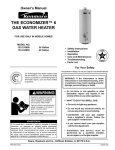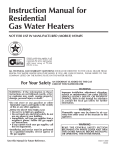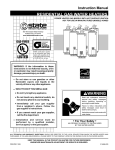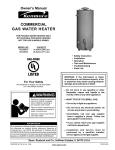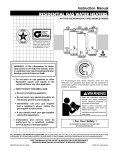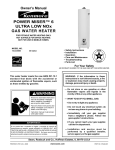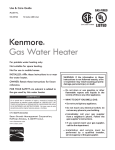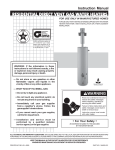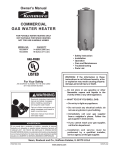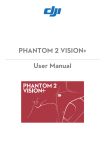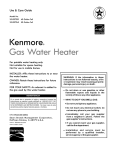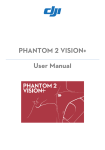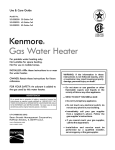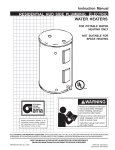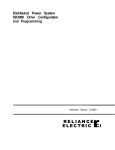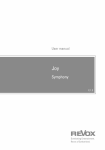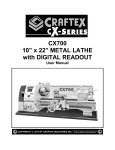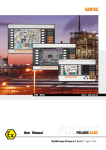Download State Industries Green Choice User's Manual
Transcript
Instruction Manual RESIDENTIAL DIRECT VENT GAS WATER HEATERS NOT FOR USE IN MANUFACTURED (MOBILE) HOMES GAMA certification applies to all residential gas water heaters with capacities of 20 to 100 gallons with input rating of 75,000 BTU/Hr. or less. • For Your Safety • AN ODORANT IS ADDED TO THE GAS USED BY THIS WATER HEATER. ALL TECHNICAL AND WARRANTY QUESTIONS: SHOULD BE DIRECTED TO THE LOCAL DEALER FROM WHOM THE WATER HEATER WAS PURCHASED. IF YOU ARE UNSUCCESSFUL, PLEASE WRITE TO THE COMPANY LISTED ON THE RATING PLATE ON THE WATER HEATER. PRINTED 1005 KEEP THIS MANUAL IN THE POCKET ON HEATER FOR FUTURE REFERENCE WHENEVER MAINTENANCE ADJUSTMENT OR SERVICE IS REQUIRED. 1 183774-001 SAFE INSTALLATION, USE AND SERVICE Your safety and the safety of others is extremely important in the installation, use and servicing of this water heater. Many safety-related messages and instructions have been provided in this manual and on your own water heater to warn you and others of a potential injury hazard. Read and obey all safety messages and instructions throughout this manual. It is very important that the meaning of each safety message is understood by you and others who install, use or service this water heater. All safety messages will generally tell you about the type of hazard, what can happen if you do not follow the safety message and how to avoid the risk of injury. IMPORTANT DEFINITIONS • Qualified Installer: A qualified installer must have ability equivalent to a licensed tradesman in the fields of plumbing, air supply, venting and gas supply, including a thorough understanding of the requirements of the National Fuel Gas Code as it relates to the installation of gas fired water heaters. The qualified installer must also be familiar with the design features and use of flammable vapor ignition resistant water heaters, and have a thorough understanding of this instruction manual. • Service Agency: A service agency also must have ability equivalent to a licensed tradesman in the fields of plumbing, air supply, venting and gas supply, including a thorough understanding of the requirements of the National Fuel Gas Code as it relates to the installation of gas fired water heaters. The service agency must also have a thorough understanding of this instruction manual, and be able to perform repairs strictly in accordance with the service guidelines provided by the manufacturer. • Gas Supplier: The Natural Gas or Propane Utility or service who supplies gas for utilization by the gas burning appliances within this application. The gas supplier typically has responsibility for the inspection and code approval of gas piping up to and including the Natural Gas meter or Propane storage tank of a building. Many gas suppliers also offer service and inspection of appliances within the building. • Piezo-Electric Spark Gas Ignition System: A combination of a piezo-electric spark generator, high voltage lead(s) and a spark electrode(s) designed to ignite pilot burner gas at an appliance burner. 2 GENERAL SAFETY 3 TABLE OF CONTENTS SAFE INSTALLATION, USE AND SERVICE ............................... 2 GENERAL SAFETY .................................................................. 3 TABLE OF CONTENTS .............................................................. 4 INTRODUCTION ........................................................................ 4 Preparing for the New Installation ................................... 4 TYPICAL INSTALLATION ...................................................... 5-6 LOCATING THE NEW WATER HEATER ..................................... 7 Facts to Consider About Location ............................... 7-8 Venting Clearances .......................................................... 8 Optional Wire Grill ............................................................ 9 Flue Extensions ................................................................ 9 Vertical Height (Extension Kit) ....................................... 10 Horizontal (Extension Kit) .............................................. 10 Vent Installations ....................................................... 11-24 INSTALLING THE NEW WATER HEATER ................................ 25 Water Piping ................................................................... 25 Temperature-Pressure Relief Valve ............................... 26 Filling the Water Heater .................................................. 27 Gas Piping ................................................................ 27-28 Sediment Traps .............................................................. 28 Installation Checklist ....................................................... 29 LIGHTING & OPERATING LABEL ............................................ 30 TEMPERATURE REGULATION ................................................ 31 FOR YOUR INFORMATION ..................................................... 31 Start Up Conditions ........................................................ 31 Condensate .................................................................... 32 Smoke/Odor .................................................................... 32 Thermal Expansion ......................................................... 32 Strange Sounds .............................................................. 32 OPERATIONAL CONDITIONS .................................................. 32 Smelly Water .................................................................. 32 “Air” in Hot Water Faucets ............................................. 32 High Temperature Shut Off System ............................... 32 PERIODIC MAINTENANCE ....................................................... 33 Venting System Inspection ............................................ 33 Burner Inspection ........................................................... 33 Burner Cleaning .............................................................. 33 Housekeeping ................................................................ 34 Anode Rod Inspection .................................................... 34 Temperature-Pressure Relief Valve Operation .............. 34 Draining .......................................................................... 34 Drain Valve Washer Replacement ................................. 35 LEAKAGE CHECKPOINTS ...................................................... 35 REPAIR PARTS ....................................................................... 36 TROUBLESHOOTING .............................................................. 40 NOTES .............................................................................. 41-43 WARRANTY ..................................................................... Insert INTRODUCTION Thank You for purchasing this water heater. Properly installed and maintained, it should give you years of trouble free service. 2. The installation must conform with these instructions and the local code authority having jurisdiction. In the absence of local codes, installations shall comply with the National Fuel Gas Code ANSI Z223.1/NFPA 54. This publication is available from the Canadian Standards Association, 8501 East Pleasant Valley Rd., Cleveland Ohio 44131, or The National Fire Protection Association, 1 Batterymarch Park, Quincy, MA 02269. Abbreviations Found In This Instruction Manual: • CSA - Canadian Standards Association • ANSI - American National Standards Institute • NFPA - National Fire Protection Association • ASME - American Society of Mechanical Engineers • GAMA - Gas Appliance Manufacturer’s Association 3. If after reading this manual you have any questions or do not understand any portion of the instructions, call the local gas utility or the manufacturer whose name appears on the rating plate. This gas-fired water heater is design certified by CSA INTERNATIONAL under American National Standard/CSA Standard for Gas Water Heaters ANSI Z21.10.1 • CSA 4.1 (current edition). 4. Carefully plan the place where you are going to put the water heater. Correct combustion, vent action and vent pipe installation are very important in preventing death from possible carbon monoxide poisoning and fires, see Figures 1 and 2. This gas-fired water heater is equipped with a piezo-electric spark device used for pilot burner ignition, and complies with the Standard for Manually-Operated Piezo-Electric Spark Gas Ignition Systems and Components, ANSI Z21.77 • CGA 6.23. Examine the location to ensure the water heater complies with the “Locating the New Water Heater” section in this manual. PREPARING FOR THE INSTALLATION 5. For California installation this water heater must be braced, anchored or strapped to avoid falling or moving during an earthquake. See instructions for correct installation procedures. Instructions may be obtained from California Office of the State Architect, 400 P Street, Sacramento, CA 95814. 1. Read the “General Safety” section, page 3 of this manual first and then the entire manual carefully. If you don’t follow the safety rules, the water heater will not operate properly. It could cause DEATH, SERIOUS BODILY INJURYAND/OR PROPERTY DAMAGE. This manual contains instructions for the installation, operation, and maintenance of the gas-fired water heater. It also contains warnings throughout the manual that you must read and be aware of. All warnings and all instructions are essential to the proper operation of the water heater and your safety. Since we cannot put everything on the first few pages, READ THE ENTIRE MANUAL BEFORE ATTEMPTING TO INSTALL OR OPERATE THE WATER HEATER. 6. Massachusetts Code requires this water heater to be installed in accordance with Massachusetts 248-CMR 2.00: State Plumbing Code and 248-CMR 5.00. 7. Complies with SCAQMD rule #1121 and districts having equivalent NOx requirements. 4 TYPICAL INSTALLATION GET TO KNOW YOUR WATER HEATER - GAS MODELS A B C D E F G H Vent Assembly Flue Outlet Anode Hot Water Outlet Outlet Insulation Gas Supply Manual Gas Shut-off Valve I J K L M N O Ground Joint Union Drip Leg (Sediment Trap) Inner Door Outer Doors with Gaskets Union Inlet Water Shut-off Valve Cold Water Inlet P Q R S T U V W X Y Z Inlet Dip Tube Temperature-Pressure Relief Valve Rating Plate Flue Baffle Thermostat Drain Valve Pilot and Main Burner Flue Drain Pan Piezo Ignitor Thermostat Shield (optional) * INSTALL IN ACCORDANCE WITH LOCAL CODES. (V) PILOT & MAIN BURNER * DRIP LEG AS REQUIRED BY LOCAL CODES. (T) THERMOSTAT * ALL PIPING MATERIALS TO BE SUPPLIED BY CUSTOMERS. FIGURE 1. 5 TYPICAL INSTALLATION MIXING VALVE USAGE FIGURE 2. HOT WATER CAN SCALD: This appliance has been design certified as complying withAmerican National Standard/CSA Standard for water heaters and is considered suitable for: Water heaters are intended to produce hot water. Water heated to a temperature which will satisfy space heating, clothes washing, dish washing, and other sanitizing needs can scald and permanently injure you upon contact. Some people are more likely to be permanently injured by hot water than others. These include the elderly, children, the infirm or physically/ mentally handicapped. If anyone using hot water in your home fits into one of these groups or if there is a local code or state law requiring a certain temperature water at the hot water tap, then you must take special precautions. In addition to using the lowest possible temperature setting that satisfies your hot water needs, a means such as a *Mixing Valve shall be used at the hot water taps used by these people or at the water heater. Mixing valves are available at plumbing supply or hardware stores. Consult a Qualified Installer or Service Agency. Follow mixing valve manufacturer’s instructions for installation of the valves. Before changing the factory setting on the thermostat, read the “Temperature Regulation” section in this manual, see Figures 109 and 110. Water (Potable) Heating: All models are “considered suitable for water (potable) heating.” Water (Potable) Heating and Space Heating: Certain models are “considered suitable for water (potable) heating and space heating.” Refer to the model and rating plate of the water heater. 6 LOCATING THE NEW WATER HEATER FACTS TO CONSIDER ABOUT THE LOCATION Carefully choose an indoor location for the new water heater, because the placement is a very important consideration for the safety of the occupants in the building and for the most economical use of the appliance. This water heater is not for use in manufactured (mobile) homes or outdoor installation. Whether replacing an old water heater or putting the water heater in a new location, the following critical points must be observed: 1. The location selected should be indoors, as close as practical to the outside wall through which the water heater vent is going to be installed, and as centralized with the water piping system as possible. The water heater, as all water heaters, will eventually leak. Do not install without adequate drainage provisions where water flow will cause damage. 2. Selected location must provide adequate clearances for servicing and proper operation of the water heater. INSTALLATIONS IN AREAS WHERE FLAMMABLE LIQUIDS (VAPORS) ARE LIKELY TO BE PRESENT OR STORED (GARAGES, STORAGE AND UTILITY AREAS, ETC.): Flammable liquids (such as gasoline, solvents, propane [LP or butane, etc.] and other substances such as adhesives, etc.) emit flammable vapors which can be ignited by a gas water heater’s pilot light or main burner. The resulting flashback and fire can cause death or serious burns to anyone in the area, as well as property damage. If installation in such areas is your only option, then the installation must be accomplished in a way that the pilot flame and main burner flame are elevated from the floor at least 18 inches (45.7 cm). While this may reduce the chances of flammable vapors, from a floor spill being ignited, gasoline and other flammable substances should never be stored or used in the same room or area containing a gas water heater or other open flame or spark producing appliance. NOTE: Flammable vapors may be drawn by air currents from other areas of the structure to the appliance. Installation of the water heater must be accomplished in such a manner that if the tank or any connections should leak, the flow will not cause damage to the structure. For this reason, it is not advisable to install the water heater in an attic or upper floor. When such locations cannot be avoided, a suitable drain pan should be installed under the water heater. Drain pans are available at your local hardware store. Such a drain pan must have a minimum length and width of at least 2 inches (5.1 cm) greater that the water heater dimensions and must be piped to an adequate drain. Drain pan depth must allow for access to the outer doors for servicing the pilot and burner. Water heater life depends upon water quality, water pressure and the environment in which the water heater is installed. Water heaters are sometimes installed in locations where leakage may result in property damage, even with the use of a drain pan piped to a drain. However, unanticipated damage can be reduced or prevented by a leak detector or water shut-off device used in conjunction with a piped drain pan. These devices are available from some plumbing supply wholesalers and retailers, and detect and react to leakage in various ways: • Sensors mounted in the drain pan that trigger an alarm or turn off the incoming water to the water heater when leakage is detected. • Sensors mounted in the drain pan that turn off the water supply to the entire home when water is detected in the drain pan. • Water supply shut-off devices that activate based on the water pressure differential between the cold water and hot water pipes connected to the water heater. • Devices that will turn off the gas supply to a gas water heater while at the same time shutting off its water supply. 7 No vent damper, whether it is operated thermally or otherwise, is to be installed on this direct vent water heater. Alteration of any part of the factory-furnished vent assembly could result in improper operation due to restriction of flue gases and may cause carbon monoxide poisoning. Also, the water heater must be located and/or protected so it is not subject to physical damage by a moving vehicle. This water heater must not be installed directly on carpeting. Carpeting must be protected by metal or wood panel beneath the appliance extending beyond the full width and depth of the appliance by at least 3 inches (7.62 cm) in any direction, or if the appliance is installed in an alcove or closet, the entire floor must be covered by the panel. Failure to heed this warning may result in a fire hazard. Venting Clearances Minimum clearances between the water heater and combustible and noncombustible construction are 0 inch at the sides, 0 inches from back, 4”(10.2 cm) from front of jacket to closet door and 3”(7.6 cm) from top of jacket to combustible and noncombustible material. Minimum vent clearance: 0 inches. When determining the installation location for a direct vent water heater, snow accumulation and drifting should be considered in areas where applicable. See Figures 4 through 8 and items below. • 18” minimum in all directions from any obstruction that may interfere. • 18” minimum from the ground and 12 “ from ceiling overhangs. • The direct vent terminal shall terminate at least 3 feet above any forced air inlet located within 10 feet. See Figure 5. • 9” minimum horizontally from or above any door, window or gravity air inlet into the building (50,000 BtuH input or less.) • 12” minimum horizontally from or above any door, window or gravity air inlet into the building (over 50,000 BtuH input). • 12” minimum below any door, window or gravity air inlet into the building (50,000 BtuH input or less). • 18” minimum below any door, window or gravity air inlet into the building (over 50,000 BtuH input). • 18” minimum from other gravity or natural appliance outlet vents when directly above or 135° to either side of center line. See Figure 6. • 36” minimum from any outlet vents when directly below or 45° to either side of center line. See Figure 7. FIGURE 3. • 36” minimum in all directions from any other forced air appliance outlet vent. See Figure 7. NOTE: Provide 24 inches (61 cm) front clearance for servicing and a adequate clearance between the jacket top and ceiling for servicing the flue area. • The location selection must provide clearances for servicing and proper operation of the water heater. See Figure 8. • Vent termination must not be within 4 feet of any items such as gas meters, gas valves or other gas regulating equipment. Combustion Air and Ventilation • Unless specified at time of ordering, a standard extension kit (No. 9000687) is individually packaged and shipped with the water heater. FIGURE 4. 8 Some local codes may require a vent cap cover. Figure 9 shows the optional wire vent cap protector available from the water heater manufacturer. A wire mesh chain link fence (see Figure 9) may be used instead of the factory cover. Care should be taken to maintain adequate ventilation around the vent cap. If a chain link fence is installed, it must not be used as a storage area for items that may block proper ventilation. FIGURE 5. FIGURE 9. Flue Extensions There are three optional extension kits available. Any combination of the three kits can be chosen; however, only one kit can be used vertically and/or horizontally, see Figures 10 & 11. Unless otherwise specified at the time of ordering, a standard extension kit (9000687) is individually packaged and shipped within the water heater carton. FIGURE 10. FIGURE 8. Optional Wire Grill When the water heater vent cap is low enough to be touched accidentally, or is accessible to small children, installation of a protective vent cover is recommended. See Figure 9. 9 Vertical Height (Extension Kit) BTU’s DIMENSION “F” (IN CENTIMETERS) *Gal. in 1000’s 9000687 Cap. Nat/L.P 40 36/36 50 38/38 40 40/40 50 48/44 75 55 NAT. 9001246 9001247 9001248 STD. MIN. MAX. MIN. MAX. MIN. MAX. 162 183 162 193 194 183 205 183 214 215 196 218 196 228 227 196 219 196 228 227 224 247 224 256 255 224 247 224 256 255 279 302 279 312 311 *Check the model and rating plate attached to the water heater for specific model number and other detailed information. Horizontal (Extension Kit) To determine the horizontal length and extension kit needed, simply plug the dimensions “D” and “G” into the equation below. The answer “E” should then be located in Chart #2. The size range in which “E” dimension falls indicates the kit that should be used horizontally to obtain the desired length. It is simple to determine which kit is needed for vertical height. Take the total height (to the top of the flue) required and comparing that to “F dimension” in the chart #1, it can be determined which kit needs to be used vertically. “D” = The wall thickness “G” = The distance wanted between the edge of the water heater and the inside edge of the wall “E” = The distance the extension kit must be able to extend The Equation: D + G = E FIGURE 11. FIGURE 13 . CHART #2. DIMENSION “E” (IN INCHES) 40-50 GAL. VENT KITS 9000687-Std. 9001246 9001247 9001248 MIN 75 GAL. MAX 3 1/2 10 15 1/2 26 1/2 10 15 1/2 26 1/2 48 MIN MAX 7/8 7 3/8 12 7/8 23 7/8 7 3/8 12 7/8 23 7/8 45 3/8 DIMENSION “E” (IN CENTIMETERS) 40-50 GAL. VENT KITS 9000687-Std. 9001246 9001247 9001248 FIGURE 12. CHART #1. BTU’s *Gal. in 1000’s Cap. Nat/L.P 40 36/36 50 38/38 40 40/40 50 48/44 75 55 NAT. DIMENSION “F” (IN INCHES) 9000687 STD. 9001246 MIN. MAX. 9001247 MIN. MAX. BTU’s 9001248 MIN. MIN 8.9 cm 25.4 cm 39.4 cm 67.3 cm 75 GAL. MAX MIN 25.4 cm 29.4 cm 67.3 cm 121.9 cm 2.2 cm 18.7 cm 32.7 cm 60.6 cm MAX 18.7 cm 32.7 cm 60.6 cm 115.3 cm DIMENSION “A, B, C” ( INCHES /CENTIMETERS ) *Gal. in 1000’s MAX. Cap. 63 3/4 72 77 77 88 88 110 72 80 3/4 86 86 1/4 97 1/4 97 1/4 118 3/4 63 3/4 72 77 77 88 88 110 76 84 1/4 89 3/4 89 3/4 100 3/4 100 3/4 122 3/4 76 1/4 84 1/2 89 1/2 89 1/2 100 1/2 100 1/2 122 1/2 Nat. 40 36/36 48 3/4” 50 38/38 57 1/2” 40 40/40 48 3/4” 50 48/44 61” 75 55 NAT. 63” 10 A 124 cm 146 cm 124 cm 155 cm 160 cm B 41 3/4” 50 1/2” 41 3/4” 54” 54 3/4” C 106 cm 21” 128 cm 21” 106 cm 21” 137 cm 21” 139 cm 26 1/4” 53 cm 53 cm 53 cm 53 cm 67 cm ALL INSTALLATIONS Standard Vent Kit - Installation #1 For ease of assembly the installation of the various kit combinations has been broken into individual sections. The two steps below are common to all installations. Once these have been performed, you need only to refer to the type installation that pertains to you. The opening through the wall should be cut at this time. If this has not been done, refer to “Cutting The Opening Through The Outside Wall ” section. Installation Using Vent Kits: 1. Standard Vent Kit 9000687 ............................................. 2. Optional Vertical Vent Kit ................................................. with Standard Vent Kit 3. Optional Horizontal Vent Kit ............................................. 4. Optional Horizontal .......................................................... and Vertical Vent Kits Page 11 Page 14 Page 17 Page 19 Cutting The Opening Through The Outside Wall After thoroughly reading the “Locating the New Water Heater” section of this manual and you have chosen a suitable water heater installation site, use Chart #1 to determine dimensions for the wall opening. 1. Lock the elbow to the straight 3” (76 mm) flue pipe. Set this assembly in place on the end of the water heater’s flue collar. Cut a 6 1/4” (159 mm) diameter hole completely through the outside wall. FIGURE 15. 2. Mark the flue collar at the slots in the elbow. Using a #22 drill bit, drill holes into the flue collar at the two slots and secure the elbow to the flue collar using the screws provided. FIGURE 14. NOTE: Make sure elbow is properly aligned to opening in the outside wall. Water Heater Attitude There is a certain amount of variance with regard to the direction the water heater faces. Standing in front of the water heater (gas control facing you), set the 3” (76 mm) diameter elbow (slotted end) on the flue. This will give you a better understanding of the relation of the vent assembly to the opening in the wall and more importantly any possibility of interference of venting and water piping. The direction of the water heater can now be made. Also consider the gas control valve to insure installation, lighting and maintenance accessibility are retained. FIGURE 16 . 3. Using the tube of sealant supplied, run an ample amount around the oval flare of the jacket. NOTE: Supplementary installation instructions are applicable only if this direct vent water heater is provided with the alternate brown porcelain-enameled vent cap and the 6” (152 mm) vent wall assembly show below, See pages 22 thru 24. FIGURE 17. 11 4. First remove the 3” (76 mm) horizontal extension from the elbow. Starting with the long end (with four securing holes), place the 6” (152 mm) diameter vent elbow over the 3” (76 mm) diameter elbow. Bend the round end “oval” to fit the flared oval end of the jacket top. FIGURE 21. 8. Slide the vent collar (to be installed later) over the 6” (152 mm) vent elbow. FIGURE 18. 5. Making sure the 6” (152 mm) diameter elbow is centered around the 3” (76 mm) diameter flue, secure the 6” (152 mm) diameter vent pipe using four sheet metal screws at the connection of the jacket top. FIGURE 22. 9. Place the water heater at the opening in the wall, at the predetermined clearance. FIGURE 19 . 6. The standard vent kit includes a 6” (152 mm) diameter extension pipe which is used when “E” dimension is over 6 1/2” (165 mm). FIGURE 23. 10. Move outdoors with all the remaining vent parts. Using the tube of sealant supplied, run an ample amount on the inside surface of the collar assembly that will contact the exterior wall and also fill the bead on the end of the 6” ((152 mm) diameter vent collar. FIGURE 20. 7. If “E” dimension is less than 6 1/2” (165 mm) move to next step. If “E” dimension is over 6 1/2” (165 mm), assemble the 6” (152 mm) diameter extension pipe (crimped end) to the 6” (152 mm) diameter vent elbow and secure using two sheet metal screws. Apply an ample amount of sealant around the joint to ensure a good seal. FIGURE 24. 12 15. The vent cap has four holes around the outer edge. Remove the four screws used to temporarily attach the collar to the exterior wall. Then secure the vent cap assembly with the vent collar assembly to the exterior wall using the same four screws. 11. Install the vent collar assembly through the wall, connecting it to the extension and/or elbow (depending on which one was used). NOTE: Screws are supplied: However, substitution may be necessary depending on the exterior wall material. FIGURE 25. 12. We have supplied four wood screws to temporarily attach the collar to the exterior wall of the building. However, other types of screws may have to be substituted depending on the material used in the construction of the exterior wall. FIGURE28. 16. Go back indoors to attach inside collar to the inside wall. Place the collar against the wall. Secure to wall by using four long sheet metal screws. FIGURE 26. NOTE: Screws are supplied: However, substitution may be necessary depending on the interior wall material. 13. Insert the 3” (76 mm) diameter flue extension pipe into the vent collar assembly (flared & notched end first) and lock (turn clockwise to lock studs to slots) the flue extension pipe to the flue elbow. FIGURE 29. 17. Using the tube of sealant supplied, run an ample amount of sealant around the edge of the vent pipe where it is inserted through the inside collar to seal air drafts from wall. 14. Connect the vent cap by sliding its end over the 3” (76 mm) diameter extension pipe and O-ring. NOTE: To facilitate ease of assembly of the vent cap to the 3” (76 mm) pipe, a soap solution can be applied to the O-ring gasket. FIGURE 27. FIGURE 30. 13 2. Set the vertical 3” (76 mm) diameter telescoping flue section in place on the flue collar. Using a # 22 drill bit, drill two holes (180° apart) and secure the vertical assembly to the flue collar. Optional Vertical Vent Kit with Standard Horizontal Vent Kit - Installation #2 Any Optional Vent Kit FIGURE 33. 3. Slide the 6” (152 mm) vent telescoping section apart to reveal the beads. Using the caulking supplied, fill the beads. *Each part is stamped with a part number. The opening through the wall should be cut at this time. If this has not been done, refer to “Cutting The Opening Through The Outside Wall,” on page 11. 1. First it must be determined how far the vertical 3” (76 mm) diameter telescoping flue sections are set and locked together using the two screws supplied. FIGURE34. 4. Apply an ample amount of sealant around the oval flare of the jacket. FIGURE 31 . Use chart #3, drawing and simple equation below, to find the length of expansion of the telescoping flue sections. Because of manufacturing tolerances, place the telescoping extension on the water heater and adjust the height (“X” Dimension) and mark the point. Once the length has been determined, lock the two sections together by drilling two holes (180° apart) in the pipe and securing with the screws supplied. FIGURE 35. 5. Place the 6” (152 mm) vent section over the 3” (76 mm) flue section. Subtract 3/4” (19 mm) from the predetermined “X” dimension. This determines the length of the 6” (152 mm) vent extension. Slide the 6” (152 mm) vent extension apart to this dimension and secure with the two screws supplied. FIGURE 36. 6. Form the round end of the 6” (152 mm) vent extension to the top of the jacket and secure with four sheet metal screws. FIGURE 32. CHART #3 *GAL CAP. 40 50 40 50 75 *BTU’s in 1000’s - NAT./L.P. 36/36 38/38 40/40 48/44 55 NAT. A 48 3/4” 57 1/2” 48 3/4” 61” 63” 124 cm 146 cm 124 cm 155 cm 160 cm *Check the model and rating plate attached to the water heater for specific model number and other detailed information. FIGURE 37. 14 10. If “E” dimension is less than 6 1/2” (165 mm) move to next step. If “E” dimension is over 6 1/2” (165 mm), assemble the 6” (152 mm) diameter extension pipe to the 6” (152 mm) diameter vent elbow and secure using two sheet metal screws. Using the tube of sealant supplied, run an ample amount around the joint to insure a good seal. 7. Place the 3” (76 mm) elbow on the flue extension. NOTE: Make sure elbow is properly aligned to opening in the outside wall. Mark the 3” (76 mm) diameter end of the flue extension at the slots in the elbow. Using a #22 drill bit, drill holes into the flue extension at the two slots and secure the elbow to the flue extension using the screws provided. FIGURE 41. 11. Slide the vent collar (to be installed later) over the 6” (152 mm) vent elbow. FIGURE 38. 8. Be sure the 6” (152 mm) diameter elbow is centered around the 3” (76 mm) diameter flue. Secure the 6” (152 mm) diameter vent pipe using two sheet metal screws at the cnnection of the elbow and 6” (152 mm) vertical extension. FIGURE 42. 12. Move the water heater into position at the vent opening. FIGURE 39. 9. The standard vent kit includes a 6” (152 mm) diameter extension pipe which is used when dimension “E” (refer to Chart 2) is over 6 1/2” (165 mm). FIGURE43. 13. Take the remaining vent parts outside to complete the installation. Using the tube of sealant supplied, apply an ample amount of sealant to the inside surface of the collar assembly that will contact the exterior wall. Also, apply sealant to the bead around the outside edge at the end of the 6” (152 mm) diameter vent collar. FIGURE 40. FIGURE 44. 15 14. Install the vent collar assembly through the wall, connecting it to the extension and /or elbow depending on which one was used. 18. The vent cap has four holes around the outer edge. Remove the four screws used to temporarily attach the collar to the exterior wall. Then secure the vent cap to the exterior wall using the same four screws. NOTE: Screws are supplied. However, substitution may be necessary depending on the exterior wall material. FIGURE 45. 15. Four wood screws are supplied to temporarily attach the collar to the exterior wall of the building. However, other types of screws may have to be substituted depending on the construction material of the exterior wall. FIGURE 49. 19. Go back indoors to attach inside collar to the inside wall. Place the collar against the wall. Secure to wall by using four long sheet metal screws. NOTE: Screws are supplied. However, substitution may be necessary depending on the exterior wall material. FIGURE46. 16. Insert the 3” (76 mm) diameter flue extension pipe into the vent collar assembly (flared and notched end first) and rotate clockwise to lock the studs to the slots in the extension pipe. FIGURE 50. FIGURE 47. 20. Using the tube of sealant supplied, apply an ample amount of sealant around the edge of the vent pipe where it is inserted through the inside collar. This will seal air draft from the walls. 17. Connect the vent cap by sliding it’s end over the 3” (7.6 cm) diameter extension pipe an O-ring. NOTE: to facilitate ease of assembly of the vent cap to the 3” (7.6 cm) pipe a soap solution can be applied to the O-ring gasket. FIGURE48. FIGURE 51. 16 Optional Horizontal Vent Kit - Installation #3 FIGURE 54. 4. First remove the 3” (7.6 cm) horizontal extension from the elbow. Starting with the long end, which has four mounting holes, place the 6” (152 mm) diameter vent elbow over the 3” (76 mm) elbow. Bend the round end to fit the flared oval end of the jacket top. If the vent hole has not been cut, refer to “Cutting The Opening Through The Outside Wall.” See page 11. 1. Lock the elbow to the straight 3” (76 mm) flue pipe. Set this assembly in place on the end of the water heater’s flue collar. FIGURE 55. 5. Be sure the 6” (152 mm) diameter elbow is centered around the 3” (76 mm) diameter flue. Secure the vent pipe with four sheet metal screws at the connection at the jacket top. FIGURE 52. FIGURE 56. 2. Mark the flue collar at the slots in the elbow. Using a # 22 drill bit, drill holes into the collar at the two slots and secure the elbow to the collar with the screws provided. NOTE: the standard kit includes a 3” (76 mm) flue extension and a 6” (152 mm) elbow extension. These parts will not be used with the horizontal kit. NOTE: make sure elbow is properly aligned to the opening in the outside wall. 6. Slide the vent collar (to be installed later) over the 6” (152 mm) vent elbow. FIGURE 53. 3. Using the tube of sealant supplied run an ample amount around the oval flare of the jacket. FIGURE 57. 17 11. Insert the vent collar assembly through the wall opening, connecting to the 6” (152 mm) telescoping extension. Remember, the vent extension has not been connected so it may be necessary to go back outdoors and push it back up into the wall opening for a tight fit to the collar. 7. Place the waterheater at the opening in the wall at the predetermined clearance. FIGURE 62. 12. Four wood screws were supplied to temporarily attach the collar to the exterior wall of the building. However, you may have to substitute other types of screws depending on the construction material of the exterior wall. FIGURE 58. 8. Slide the 6” (152 mm) telescoping vent section apart to expose the beads. Use the supplied tube of sealant and fill the exposed beads. FIGURE 63. 13. Insert the vent cap into the vent collar assembly. FIGURE 59. 9. Insert the 6” (152 mm) telescoping vent section into the opening in the wall. FIGURE 64. 14. The vent cap has four holes around the outer edge. Remove the four screws used to temporarily attach the collar to the exterior wall. Then secure the vent cap assembly with the vent collar assembly to the exterior wall using the same screws. FIGURE 60. Note: Screws are supplied; however, substitution may be necessary depending on the exterior wall material. 10. The remaining vent parts will be installed from the outside. Apply ample amount of sealant to the inside surface of the collar assembly that will contact the exterior wall. Also, apply sealant to the bead around the outside edge at the end of the 6” (152 mm) diameter vent collar. FIGURE 65. 15. The remainder of the installation will be indoors to complete the assembly process. FIGURE 61. 18 20. Secure the 6” (15.2 cm) vent extension to the vent elbow with the two provided screws spacing them 180° apart. 16. Collapse the 6” flue extension assembly as shown below. Install the O-ring end of the 3” (7.6 cm) extension approximately 1 1/4” (3.2 cm) into the end of the vent cap. If necessary, apply a soap solution to the O-ring to ease the assembly. Rotate the 3” extension clockwise until the other end is locked to the studs on the elbow. FIGURE 70. Optional Vertical and Horizontal Vent Kit Installation #4 FIGURE 66. 17. Using a # 22 drill bit, drill holes 180° apart at the connection point of the two 3” (7.6 cm) flue extensions. Secure with the two screws provided. FIGURE 67. 18. Expand the 6” (15.2 cm) telescoping extension to connect at the vent elbow. If the vent hole has not been cut, refer to section, “Cutting The Opening Through The Outside Wall.” See page 11. 1. First determine how far the vertical 3” (7.6 cm) diameter telescoping flue sections are to be set and locked together with two screws supplied. FIGURE 68. 19. Push the vent collar from the elbow against the wall and secure with the four provided screws. FIGURE 71. Use the Chart #4, and figure 72 to determine the length of expansion of the telescoping flue sections. Because of manufacturing tolerances, put the telescoping extension on the water heater, adjust the height (dimension “X”) and mark the point. Once the length has been determined, lock the two sections together by drilling two holes (180° apart) in the pipe and secure with the supplied screws. FIGURE 69. 19 5. Place the 6” (15.2 cm) vent section over the 3” (7.6 cm) flue section. Subtract 3/4” (1.9 cm) from the predetermined “X” dimension. This determines the length of the 6” (15.2 cm) vent extension. Slide the 6” (15.2 cm) vent extension apart to this dimension and secure with the two screws supplied. FIGURE 72. CHART #4. *GAL CAP *BTU’s in 1000’s - NAT./L.P. A 40 36/36 48 3/4” 124 cm 50 38/38 57 1/2” 146 cm 40 40/40 48 3/4” 124 cm 50 48/44 61” 155 cm 75 55 NAT. 63” 160 cm *Check the model and rating plate attached to the water heater for specific model number and other detailed information. FIGURE 76. 6. Form the round end of the 6” (15.2 cm) vent extension to the top of the jacket and secure with four sheet metal screws. 2. Set the vertical 3” (7.6 cm) diameter telescoping flue section in place on the flue collar. Using a #22 drill bit, drill two holes (180° apart) and secure the vertical assembly to the flue collar with the two supplied screws. FIGURE 77. 7. Place the 3” (7.6 cm) elbow on the flue extension. Align the elbow to the hole previously made in the outside wall. Using the slots in the elbow, mark the 3” (7.6 cm) diameter end of the flue extension. Using a #22 drill bit, drill two holes into the flue extension and secure with the two provided sheet metal screws. FIGURE 73. 3. Slide the 6” (15.2 cm) vent telescoping section apart to reveal the beads. Fill the beads using the supplied caulking. FIGURE 74. FIGURE 78. 4. Apply an ample amount of sealant around the oval flare of the jacket. NOTE: the standard kit includes a 3” (7.6 cm) flue extension and a 6” (15.2 cm) elbow extension. These parts will not be used with the horizontal kit. FIGURE 75. 20 8. Be sure the 6” (15.2 cm) diameter elbow is centered around the 3” (7.6 cm) diameter flue, secure using two sheet metal screws at the connection of the elbow and the 6” (15.2 cm) vertical extension. 11. Slide the 6” (15.2 cm) telescoping vent section apart to expose the beads. Use the supplied tube of caulking and fill the exposed beads. FIGURE 82. 12. Insert the 6” (15.2 cm) telescoping vent section into the wall. FIGURE 79. 9. Slide the vent collar (to be installed later) over the 6” (15.2 cm) vent elbow. FIGURE 83. 13. The remaining vent parts will be installed from the outside. Apply ample amount of sealant to the inside surface of the collar assembly that will contact the exterior wall. Also, apply sealant to the bead around the outside edge at the end of the 6” (15.2 cm) diameter vent collar. FIGURE 80. 10. Move the water heater into position at the vent opening. FIGURE 84. 14. Install the vent collar assembly through the wall, connecting to the 6” (15.2 cm) telescoping extension. Remember, the extension is not connected and may be necessary to return indoors to push the extension back against the interior wall for a tight fit to the collar. FIGURE 85. FIGURE 81. 21 15. Four wood screws were supplied to temporarily attach the collar to the exterior wall of the building. However, you may have to substitute other types of screws depending on the construction material of the exterior wall. 20. Using a #22 drill bit, drill holes 180° apart at the connection point of the two 3” (76 mm) flue extensions. Secure with the two screws provided. FIGURE 86. 16. Insert the vent cap into the vent collar assembly. FIGURE 90. 21. Expand the 6” (152 mm) telescoping extension pipes to connect at the vent elbow. FIGURE 87. 17. The vent cap has four holes around the outer edge. Remove the four screws used to temporarily attach the collar to the exterior wall. Then secure the vent cap assembly with the vent collar assembly to the exterior wall using the same screws. Note: Screws are supplied; however, substitution may be necessary depending on the exterior wall material. FIGURE 91. 22. Push the vent collar from the elbow against the wall and secure with the four provided screws. FIGURE 88. 18. The remainder of the installation will be conducted indoors to complete the assembly process. 19. Collapse the 6” extension assembly as shown below. Install the Oring end of the 3” (7.6 cm) extension approximately 11/4” (3.2 cm) into the end of the vent cap. If necessary, apply a soap solution to the O-ring to ease the assembly. Rotate the extension clockwise until the other end is locked to the studs on the elbow. FIGURE 92. 23. Secure the 6” (152 mm) vent extension to the vent elbow with the two provided screws spacing them 180° apart. FIGURE 93. Optional Vent Cap - Porcelain-Enameled These supplementary installation instructions are applicable only if this direct vent water heater is provided with the alternate brown FIGURE 89. 22 porcelain-enameled vent cap assembly and the 6” (15.2 cm) vent wall assembly shown by Figure 94. 16. Insert the 3” (7.6 cm) diameter flue extension pipe into the vent collar assembly (flared and notched end first). Lock the flue extension pipe to the flue elbow by rotating clockwise to lock studs to slots. FIGURE 94. FIGURE 97. The water heater model designation on the rating plate will have a suffix “P” to indicate this alternate vent cap assembly. 4. Connect the vent cap by sliding it over the 3” (7.6 cm) diameter extension pipe and O-ring. The alternate installation instructions below will replace the itemized instructions in the manual as follows: Items 11 thru 15 on page 13 and items 14 thru 18 on page 16. NOTE: for ease of assembly of the vent cap to the 3” (7.6 cm) pipe a soap solution can be applied to the O-ring gasket. 1. Making sure the arrow points “UP”, install the vent collar assembly through the wall, connecting it to the extension and/or elbow depending on which one was used. FIGURE 98. 5. The vent cap has six holes around the outer edge. The three larger ones are to fit over the three screws securing the vent collar assembly to the exterior wall. The three smaller ones will now be used to attach the vent cap assembly. FIGURE 95. 2. Three wood screws are supplied to attach the collar to the exterior wall of the building. However, other types of screws may have to be substituted depending on the construction of the exterior wall. NOTE: screws are supplied. However, substitution may be necessary depending on the exterior wall material. NOTE: alternate screws used must not have a head larger than 3/8” (.95 cm). The three screws must be placed at every other hole (120° apart) to secure the vent collar assembly to the outside wall. FIGURE 99. FIGURE 96. 23 The following alternate illustrated instructions will replace the itemized instructions in the manual as follows: Items 11 through 14 on page 18 and Items 14 through 17 on pages 21 and 22. 3. Insert the vent cap in the vent collar assembly. 1. Making sure the arrow points “up”, install the vent collar assembly through the wall, connecting it to the 6” (15.2 cm) telescoping extension. Remember, the extension is not connected, and it may be necessary to return indoors to push the extension back against the interior wall for a tight fit to the collar. FIGURE 102. FIGURE 100. 4. The vent cap has six holes around its outer edge. The three larger ones are to fit over the three screws securing the vent collar assembly to the exterior wall. The three smaller ones will now be used to attach the vent cap assembly. 2. Three wood screws are supplied to attach the collar to the exterior wall of the building. However, other types of screws may be substituted depending on the construction of the exterior wall. NOTE: screws are supplied. However, substitution may be necessary, depending on the exterior wall material. NOTE: alternate screws used must not have heads larger than 3/8” (.95 cm). The three screws must be placed at every other hole 120° apart to secure the vent collar assembly to the outside wall. FIGURE 103. FIGURE 101. 24 INSTALLING THE NEW WATER HEATER WATER PIPING As water is heated, it expands (thermal expansion) and closed systems do not allow for the expansion of heated water. The water within the water heater tank expands as it is heated and increases the pressure of the water system. If the relieving point of the water heater’s temperature-pressure relief valve is reached, the valve will relieve the excess pressure. The temperature-pressure relief valve is not intended for the constant relief of thermal expansion. This is an unacceptable condition and must be corrected. It is recommended that any devices installed which could create a closed system have a by-pass and/or the system have an expansion tank to relieve the pressure built by thermal expansion in the water system. Expansion tanks are available for ordering through a local plumbing contractor. Contact the local water supplier and/or a service agency for assistance in controlling these situations. NOTE: To protect against untimely corrosion of hot and cold water fittings, it is strongly recommended that di-electric unions or couplings be installed on this water heater when connected to copper pipe. HOTTER WATER CAN SCALD: Water heaters are intended to produce hot water. Water heated to a temperature which will satisfy space heating, clothes washing, dish washing, cleaning and other sanitizing needs can scald and permanently injure you upon contact. Some people are more likely to be permanently injured by hot water than others. These include the elderly, children, the infirm, or physically/mentally handicapped. If anyone using hot water in your home fits into one of these groups or if there is a local code or state law requiring a certain temperature water at the hot water tap, then you must take special precautions. In addition to using the lowest possible temperature setting that satisfies your hot water needs, a means such as a *mixing valve, shall be used at the hot water taps used by these people or at the water heater, see Figure. Valves for reducing point of use temperature by mixing cold and hot water are also available. Consult a Qualified Installer or Service Agency. Follow manufacturer’s instructions for installation of the valves. Before changing the factory setting on the thermostat, read the “Temperature Regulation” section in this manual. This water heater shall not be connected to any heating systems or component(s) used with a non-potable water heating appliance. All piping components connected to this unit for space heating applications shall be suitable for use with potable water. Toxic chemicals, such as those used for boiler treatment shall not be introduced into this system. When the system requires water for space heating at temperatures higher than required for domestic water purposes, a tempering valve must be installed. Please refer to Figure 2 for suggested piping arrangement. Water supply systems may, because of such events as high line pressure, frequent cut-offs, the effects of water hammer among others, have installed devices such as pressure reducing valves, check valves, back flow preventers, etc. to control these types of problems. When these devices are not equipped with an internal by-pass, and no other measures are taken, the devices cause the water system to be closed. FIGURE 104. 25 Figure 104 shows the typical attachment of the water piping to the water heater. The water heater is equipped with 3/4 inch NPT water connections. The valve must be marked with a maximum set pressure not to exceed the marked hydrostatic working pressure of the water heater (150 psi = 1,035 kPa) and a discharge capacity not less than the water heater input rate as shown on the model rating plate. NOTE: If using copper tubing, solder tubing to an adapter before attaching the adapter to the cold water inlet connection. Do not solder the cold water supply line directly to the cold water inlet. It will harm the dip tube and damage the tank. For safe operation of the water heater, the relief valve must not be removed from its designated opening nor plugged. The temperature-pressure relief valve must be installed directly into the fitting of the water heater designed for the relief valve. Position the valve downward and provide tubing so that any discharge will exit only within 6 inches (153 mm) above, or at any distance below the structural floor. Be certain that no contact is made with any live electrical part. The discharge opening must not be blocked or reduced in size under any circumstances. Excessive length, over 30 feet (9.14 m), or use of more than four elbows can cause restriction and reduce the discharge capacity of the valve, see Figure 106. T & P Valve and Pipe Insulation Remove insulation for T & P valve and pipe connections from carton. No valve or other obstruction is to be placed between the relief valve and the tank. Do not connect tubing directly to discharge drain unless a 6 inch air gap is provided. To prevent bodily injury, hazard to life, or property damage, the relief valve must be allowed to discharge water in quantities should circumstances demand. If the discharge pipe is not connected to a drain or other suitable means, the water flow may cause property damage. FIGURE 105. Fit pipe insulation over the incoming cold water line and the hot water line. Make sure that the insulation is against the top cover of the heater. Fit T & P valve insulation over valve. Make sure that the insulation does not interfere with the lever of the T & P valve. Secure all insulation using tape. The Discharge Pipe: TEMPERATURE-PRESSURE RELIEF VALVE • Shall not be smaller in size than the outlet pipe size of the valve, or have any reducing couplings or other restrictions. • Shall not be plugged or blocked. • Shall be of material listed for hot water distribution. • Shall be installed so as to allow complete drainage of both the temperature-pressure relief valve, and the discharge pipe. • Shall terminate at an adequate drain. • Shall not have any valve between the relief valve and tank. This heater is provided with a properly certified combination temperature - pressure relief valve by the manufacturer. The valve is certified by a nationally recognized testing laboratory that maintains periodic inspection of production of listed equipment of materials as meeting the requirements for Relief Valves and Automatic Gas Shut-off Devices for Hot Water Supply Systems, ANSI Z21.22 • CSA 4.4, and the code requirements of ASME. The temperature-pressure relief valve must be manually operated at least once a year. Caution should be taken to ensure that (1) no one is in front of or around the outlet of the temperature-pressure relief valve discharge line, and (2) the water manually discharged will not cause any bodily injury or property damage because the water may be extremely hot. If replaced, the valve must meet the requirements of local codes, but not less than a combination temperature and pressure relief valve certified as indicated in the above paragraph. 26 If after manually operating the valve, it fails to completely reset and continues to release water, immediately close the cold water inlet to the water heater, follow the draining instructions, and replace the temperature-pressure relief valve with a new one. GAS PIPING Make sure the gas supplied is the same type listed on the model rating plate. The inlet gas pressure must not exceed 14 inch water column (2.6 kPa) for natural and propane gas (L.P.). The minimum inlet gas pressure shown on the rating plate is that which will permit firing at rated input. If the gas control valve is subjected to pressures exceeding 1/2 pound per square inch (3.5 kPa), the damage to the gas control valve could result in a fire or explosion from leaking gas. If the main gas line Shut-off serving all gas appliances is used, also turn “off” the gas at each appliance. Leave all gas appliances shut “off” until the water heater installation is complete. FIGURE 106. A gas line of sufficient size must be run to the water heater. Consult the current edition of National Fuel Gas Code ANSI Z223.1/NFPA 54 and your gas supplier concerning pipe size. FILLING THE WATER HEATER There must be: • A readily accessible manual shut off valve in the gas supply line serving the water heater, and • A drip leg (sediment trap) ahead of the gas control valve to help prevent dirt and foreign materials from entering the gas control valve. • A flexible gas connector or a ground joint union between the shut off valve and control valve to permit servicing of the unit. Be sure to check all the gas piping for leaks before lighting the water heater. Use a soapy water solution, not a match or open flame. Rinse off soapy solution and wipe dry. Never use this water heater unless it is completely full of water. To prevent damage to the tank, the tank must be filled with water. Water must flow from the hot water faucet before turning “ON” gas to the water heater. To fill the water heater with water: 1. Close the water heater drain valve by turning the handle to the right (clockwise). The drain valve is on the lower front of the water heater. 2. Open the cold water supply valve to the water heater. NOTE: The cold water supply valve must be left open when the water heater is in use. 3. To insure complete filling of the tank, allow air to exit by opening the nearest hot water faucet. Allow water to run until a constant flow is obtained. This will let air out of the water heater and the piping. 4. Check all water piping and connections for leaks. Repair as needed. 27 When installed at elevations above 2,000 feet (610 meters), input rating should be reduced at the rate of 4 percent for each 1,000 feet (305 meters) above sea level which requires replacement of the burner orifice in accordance with National Fuel Gas Code ANSI Z223.1/ NFPA 54. Contact your local gas supplier for further information. GAS PIPING WITH ALL BLACK IRON PIPE TO GAS CONTROL Failure to replace the standard orifice with a high altitude orifice when installed could result in improper and inefficient operation of the appliance, producing carbon monoxide gas in excess of safe limits, which could result in serious injury or death. Contact your gas supplier for any specific changes which may be required in your area. FIGURE 108. SEDIMENT TRAPS Use pipe joint compound or teflon tape marked as being resistant to the action of petroleum [Propane (L.P.)] gases. The appliance and its gas connection must be leak tested before placing the appliance in operation. The appliance and its individual Shut-off valve shall be disconnected from the gas supply piping system during any pressure testing of that system at test pressures in excess of 1/2 pound per square inch (3.5 kPa). It shall be isolated from the gas supply piping system by closing its individual manual Shut-off valve during any pressure testing of the gas supply piping system at test pressures equal to or less than 1/2 pound per square inch (3.5 kPa). A sediment trap shall be installed as close to the inlet of the water heater as practical at the time of water heater installation. The sediment trap shall be either a tee fitting with a capped nipple in the bottom outlet or other device recognized as an effective sediment trap. If a tee fitting is used, it shall be installed in conformance with one of the methods of installation shown in Figures 107 and 108. Connecting the gas piping to the gas control valve of the water heater can be accomplished by either of the two methods shown in Figures 107 and 108. GAS PIPING WITH FLEXIBLE CONNECTOR Contaminants in the gas lines may cause improper operation of the gas control valve that may result in fire or explosion. Before attaching the gas line be sure that all gas pipe is clean on the inside. To trap any dirt or foreign material in the gas supply line, a drip leg (sometimes called a sediment trap) must be incorporated in the piping. The drip leg must be readily accessible. Install in accordance with the “Gas Piping” section. Refer to the current edition of the National Fuel Gas Code, ANSI Z223.1/NFPA 54. FIGURE 107. 28 INSTALLING THE NEW WATER HEATER (cont’d.) INSTALLATION CHECKLIST BEFORE LIGHTING THE PILOT: 1. Check the gas line for leaks. a. Use a soapy water solution. DO NOT test for gas leaks using a match or open flame. b. Brush the soapy water solution on all gas pipes, joints and fittings. c. Check for bubbling soap. This means you have a leak. Turn “OFF” gas and make the necessary repairs. d. Recheck for leaks. e. Rinse off soapy solution and wipe dry. 6. Is there proper clearance between the water heater and anything that might catch fire? See the “Locating the New Water Heater” section. 7. Do you have adequate ventilation so that the water heater will operate properly? See “Combustion Air and Ventilation” in the “Locating the New Water Heater” section. 8. Is the vent piping properly secured? See “Venting” instructions in the “Installing the New Water Heater section. 9. Is there proper clearance between the vent pipe and anything that might catch fire? See “Venting” instructions in the “Installing the New Water Heater” section. 2. Is this new temperature-pressure relief valve properly installed and piped to an adequate drain? See “Temperature-Pressure Relief Valve” section. 3. Are the cold and hot water lines connected to the water heater correctly? See “Water Piping” instructions in the “Installing the New Water Heater” section. 4. Is the water heater completely filled with water? See “Filing the Water Heater” instructions in the “Installing the New Water Heater” section. 10. Is the vent pipe properly sloped and does the vent terminate outdoors? See “Venting” instructions in the “Installing the New Water Heater” section. 5. Will a water leak damage anything? See the “Locating the New Water Heater” section. 11. Do you need to call your gas company to check the gas pipe and its hookup? 29 30 TEMPERATURE REGULATION NOTE: A water temperature range of 120°F-140°F (49°C-60°C) is recommended by most dishwasher manufacturers. The thermostat of this water heater has been factory set at its lowest position (PILOT LIGHTING). It is adjustable and must be reset to the desired temperature setting to reduce the risk of scald injury. The mark ( ) indicative of approximately 120°F (49°C) is preferred starting point. Some States have a requirement for a lower setting. Turn the water temperature dial clockwise ( ) to decrease the ) to increase the temperature, or counterclockwise ( temperature. Should overheating occur or the gas supply fail to shut off, turn off the manual gas control valve to the appliance. HOT WATER CAN SCALD: Water heaters are intended to produce hot water. Water heated to a temperature that will satisfy space heating, clothes washing, dish washing, and other sanitizing needs can scald and permanently injure you upon contact. Some people are more likely to be permanently injured by hot water than others. These include the elderly, children, the infirm, or physically/mentally handicapped. If anyone using hot water in your home fits into one of these groups or if there is a local code or state law requiring a specific hot water temperature at the tap, then you must take special precautions. Never allow small children to use a hot water tap, or to draw their own bath water. Never leave a child or handicapped person unattended in a bathtub or shower. It is recommended that lower water temperatures be used to avoid the risk of scalding. It is further recommended, in all cases, that the water temperature be set for the lowest temperature that satisfies your hot water needs. This will also provide the most energy efficient operation of the water heater. FIGURE 109. Figure 110 shows the approximate water temperatures produced at various thermostat settings. Short repeated heating cycles caused by small hot water uses can cause temperatures at the point of use to exceed the thermostat setting by up to 30°F (17°C). If you experience this type of use you should consider using lower temperature settings to reduce scald hazards. Valves for reducing the point-of-use temperature by mixing cold and hot water are available. See Figure 2. Also available are inexpensive devices that attach to faucets to limit hot water temperatures. Contact a licensed plumber or the local plumbing authority. FIGURE 110. FOR YOUR INFORMATION Moisture from the products of combustion condense on the cooler tank surfaces and form drops of water which may fall onto the burner or other hot surfaces to produce a “sizzling” or “frying” noise. START UP CONDITIONS CONDENSATE Excessive condensation can cause pilot outage due to water running down the flue tube onto the main burner and putting out the pilot. Because of the suddenness and amount of water, condensation water may be diagnosed as a “tank leak”. After the water in the tank warms up (about 1-2 hours), the condition should disappear. Whenever the water heater is filled with cold water, some condensate will form while the burner is on. A water heater may appear to be leaking when in fact the water is condensation. This usually happens when: Do not assume the water heater is leaking until there has been enough time for the water in the tank to warm up. a. A new water heater is filled with cold water for the first time. b. Burning gas produces water vapor in water heaters, particularly high efficiency models where flue temperatures are lower. c. Large amounts of hot water are used in a short time and the refill water in the tank is very cold. An undersized water heater will cause more condensation. The water heater must be sized properly to meet the family’s demands for hot water including dishwashers, washing machines and shower heads. 31 will cause a reaction between this rod and the water. The most common complaint associated with the anode rod is one of a “rotten egg smell” in the hot water. This odor is derived from hydrogen sulfide gas dissolved in the water. The smell is the result of four factors which must all be present for the odor to develop: Excessive condensation may be noticed during the winter and early spring months when incoming water temperatures are at their lowest. Good venting is essential for a gas fired water heater to operate properly as well as to carry away products of combustion and water vapor. SMOKE / ODOR a. A concentration of sulfate in the supply water. b. Little or no dissolved oxygen in the water. c. A sulfate reducing bacteria which has accumulated within the water heater (this harmless bacteria is nontoxic to humans). d. An excess of active hydrogen in the tank. This is caused by the corrosion protective action of the anode. It is not uncommon to experience a small amount of smoke and odor during the initial start-up. This is due to burning off of oil from metal parts, and will disappear in a short while. THERMAL EXPANSION Smelly water may be eliminated or reduced in some water heater models by replacing the anode(s) with one of less active material, and then chlorinating the water heater tank and all hot water lines. Contact the local water heater supplier or service agency for further information concerning an Anode Replacement Kit and this chlorination treatment. If the smelly water persists after the anode replacement and chlorination treatment, we can only suggest that chlorination or aeration of the water supply be considered to eliminate the water problem. Do not remove the anode leaving the tank unprotected. By doing so, all warranty on the water heater tank is voided. Water supply systems may, because of such events as high line pressure, frequent cut-offs, the effects of water hammer among others, have installed devices such as pressure reducing valves, check valves, back flow preventers, etc. to control these types of problems. When these devices are not equipped with an internal by-pass, and no other measures are taken, the devices cause the water system to be closed. As water is heated, it expands (thermal expansion) and closed systems do not allow for the expansion of heated water. “AIR” IN HOT WATER FAUCETS The water within the water heater tank expands as it is heated and increases the pressure of the water system. If the relieving point of the water heater’s temperature-pressure relief valve is reached, the valve will relieve the excess pressure. The temperature-pressure relief valve is not intended for the constant relief of thermal expansion. This is an unacceptable condition and must be corrected. It is recommended that any devices installed which could create a closed system have a by-pass and/or the system have an expansion tank or device to relieve the pressure built by thermal expansion in the water system. Expansion tanks are available for ordering through a local plumbing contractor. Contact the local water heater supplier or service agency for assistance in controlling these situations. HYDROGEN GAS: Hydrogen gas can be produced in a hot water system that has not been used for a long period of time (generally two weeks or more). Hydrogen gas is extremely flammable and explosive. To prevent the possibility of injury under these conditions, we recommend the hot water faucet, located farthest away, be opened for several minutes before any electrical appliances which are connected to the hot water system are used (such as a dishwasher or washing machine). If hydrogen gas is present, there will probably be an unusual sound similar to air escaping through the pipe as the hot water faucet is opened. There must be no smoking or open flame near the faucet at the time it is open. STRANGE SOUNDS Possible noises due to expansion and contraction of some metal parts during periods of heat-up and cool-down do not necessarily represent harmful or dangerous conditions. Condensation causes sizzling and popping within the burner area during heating and cooling periods and should be considered normal. See “Condensation” in this section. HIGH WATER TEMPERATURE SHUT OFF SYSTEM This water heater is equipped with an automatic gas Shut-off system. This system works when high water temperatures are present. Turn “OFF” the entire gas supply to the water heater. The high temperature Shut-off is built into the gas control valve. It is non-resettable. If the high temperature Shut-off activates, the gas control valve must be replaced. Contact your gas supplier or service agency. OPERATIONAL CONDITIONS SMELLY WATER In each water heater there is installed at least one anode rod (see parts sections) for corrosion protection of the tank. Certain water conditions 32 PERIODIC MAINTENANCE VENTING SYSTEM INSPECTION You should check for sooting. Soot is not normal and will impair proper combustion. Soot build-up indicates a problem that requires correction before further use. Turn “OFF” gas to water heater and leave off until repairs are made, because failure to correct the cause of the sooting can result in a fire causing death, serious injury, or property damage. FIGURE 111. BURNER CLEANING At least once a year a visual inspection should be made of the venting system. You should look for: In the event your burner needs cleaning, follow these instructions: If inspection of the burner shows that cleaning is required, turn the gas control knob clockwise ( ) to the “OFF” position, depressing slightly. 1. Obstructions which could cause improper venting. The combustion and ventilation air flow must not be obstructed. NOTE: The knob cannot be turned from “PILOT” to “OFF” unless knob is depressed slightly. DO NOT FORCE. 2. Damage or deterioration which could cause improper venting or leakage of combustion products. Loose deposits on or around the burner can be removed by carefully using the hose of a vacuum cleaner inserted through the access doors of the water heater. If the burner needs to be removed for additional cleaning, call the local gas utility to remove and clean the burner and correct the problem that required the burner to be cleaned. 3. Rusted flakes around top of water heater. Be sure the vent piping is properly connected to prevent escape of dangerous flue gasses which could cause deadly asphyxiation. L.P. GAS CONTROL VALVE & BURNER ASSEMBLY Obstructions and deteriorated vent systems may present serious health risk or asphyxiation. Propane (L.P.) gas control valve and burner assembly replacement information. Chemical vapor corrosion of the flue and vent system may occur if air for combustion contains certain chemical vapors. Spray can propellants, cleaning solvents, refrigerator and air conditioner refrigerants, swimming pool chemicals, calcium and sodium chloride, waxes, bleach and process chemicals are typical compounds which are potentially corrosive. For Propane (L.P.) Gas Models Only: Your water heater is equipped with a Propane (L.P.) gas control valve and a main burner assembly with left hand threads for the following fittings and their connections. • The connection between the manifold and the gas control valve (A to B) are left hand threads. If after inspection of the vent system you found sooting or deterioration, something is wrong. Call the local gas utility to correct the problem and clean or replace the flue and venting before resuming operation of the water heater. • The connection between the main burner orifice and the manifold (C to D) are left hand threads. For ordering these replacement parts, please refer to the “Repair Parts” section of this manual. BURNER INSPECTION Flood damage to a water heater may not be readily visible or immediately detectable. However, over a period of time a flooded water heater will create dangerous conditions which can cause DEATH, SERIOUS BODILY INJURY, OR PROPERTY DAMAGE. Contact a qualified installer or service agency to replace a flooded water heater. Do not attempt to repair the unit! It must be replaced! At least once a year a visual inspection should be made of the main burner and pilot burner, see Figure 111. FIGURE 112. 33 The temperature-pressure relief valve must be manually operated at least once a year. HOUSEKEEPING Vacuum around base of water heater for dust, dirt, and lint on a regular basis. FIGURE 113. When checking the temperature-pressure relief valve operation, make sure that (1) no one is in front of or around the outlet of the temperaturepressure relief valve discharge line, and (2) that the water discharge will not cause any property damage, as the water may be extremely hot, see Figure 113. If after manually operating the valve, it fails to completely reset and continues to release water, immediately close the cold water inlet to the water heater, follow the draining instructions, and replace the temperature-pressure relief valve with a new one. INSTALLED IN SUITABLE AREA: To insure sufficient ventilation and combustion air supply, proper clearances from the water heater must be maintained. See “Locating the New Water Heater” section. Combustible materials such as clothing, cleaning materials, or flammable liquids, etc. must not be placed against or adjacent to the water heater which can cause a fire. If the temperature-pressure relief valve on the appliance weeps or discharges periodically, this may be due to thermal expansion. You may have a check valve installed in the water line or a water meter with a check valve. Consult your local water supplier or service agency for further information. Do not plug the temperature-pressure relief valve. ANODE ROD INSPECTION DRAINING The anode rod is used to protect the tank from corrosion. Most hot water tanks are equipped with an anode rod. The submerged rod sacrifices itself to protect the tank. Instead of corroding the tank, water ions attack and eat away the anode rod. This does not affect the water’s taste or color. The rod must be maintained to keep the tank in operating condition. The water heater should be drained if being shut down during freezing temperatures. Also periodic draining and cleaning of sediment from the tank may be necessary. Anode deterioration depends on water conductivity, not necessarily water condition. A corroded or pitted anode rod indicates high water conductivity and should be checked and/or replaced more often than an anode rod that appears to be intact. Replacement of a depleted anode rod can extend the life of your water heater. Inspection should be conducted by a qualified technician, and at a minimum should be checked annually after the warranty period. 1. Turn the gas control knob to the “OFF” position. 2. CLOSE the cold water inlet valve to the water heater. 3. OPEN a nearby hot water faucet and leave open to allow for draining. 4. Connect a hose to the drain valve and terminate to an adequate drain. TEMPERATURE-PRESSURE RELIEF VALVE OPERATION 5. OPEN the water heater drain valve to allow for tank draining. NOTE: If the water heater is going to be shut down and drained for an extended period, the drain valve should be left open with hose connected allowing water to terminate to an adequate drain. 6. CLOSE the drain valve. 7. Follow instructions in the “Filling The Water Heater” section. 8. Follow the lighting instructions on the label, see page 29 under “Lighting Instructions” to restart the water heater. 34 DRAIN VALVE WASHER REPLACEMENT 8. Follow the lighting instructions in the “Lighting” section to restart the water heater. (See Figure 114) 1. Turn “OFF” gas supply to water heater. 2. Follow “Draining” instructions. 3. Turning counterclockwise ( screw handle. ), remove the hex cap below the 4. Remove the washer and put the new one in place. 5. Screw the handle and cap assembly back into the drain valve and retighten using a wrench. DO NOT OVER TIGHTEN. 6. Follow instructions in the “Filling The Water Heater” section. 7. Check for leaks. FIGURE 114. LEAKAGE CHECKPOINTS Read this manual first. Then before checking the water heater make sure the gas supply has been turned “OFF”, and never turn the gas “ON” before the tank is completely full of water. Never use this water heater unless it is completely filled with water. To prevent damage to the tank, the tank must be filled with water. Water must flow from the hot water faucet before turning “ON” gas to the water heater. A. Water at the draft hood is water vapor which has condensed out of the combustion products. This is caused by a problem in the vent. Contact the gas utility. B. *Condensation may be seen on pipes in humid weather or pipe connections may be leaking. C. *The anode rod fitting may be leaking. D. Small amounts of water from temperature-pressure relief valve may be due to thermal expansion or high water pressure in your area. E. *The temperature-pressure relief valve may be leaking at the tank fitting. F. Water from a drain valve may be due to the valve being slightly opened. G. *The drain valve may be leaking at the tank fitting. H. Combustion products contain water vapor which can condense on the cooler surfaces of the tank. Droplets form and drip onto the burner or run on the floor. This is common at the time of start-up after installation and when incoming water is cold. I. Water in the water heater bottom or on the floor may be from condensation, loose connections, or the relief valve. DO NOT replace the water heater until a full inspection of all possible water sources is made and necessary corrective steps taken. Leakage from other appliances, water lines, or ground seepage should also be checked. * 35 To check where threaded portion enters tank, insert cotton swab between jacket opening and fitting. If cotton is wet, follow “Draining” instructions in the “Periodic Maintenance” section and then remove fitting. Put pipe dope or teflon tape on the threads and replace. Then follow “Filling the Water Heater” instructions in the “Installing the New Water Heater” section. REPAIR PARTS LIST 36 REPAIR PARTS LIST (cont’d.) PARTS GAL. CAP. KEY # DESCRIPTION BTU’s in 1000’s NAT/L.P. 1. Access Door Clips (Pkg. 2) 2. Right Access Door w/Gasket 3. Left Access Door w/Gasket 4. Burner Orifice (Nat.) (Drill Size) 4. Burner Orifice (Nat.) Hi-Altitude (Drill Size) 4. Burner Orifice (L.P.) LHT (Drill Size) 4. Burner Orifice (L.P.) Hi-Altitude/LHT (Drill Size) 5. Thermocouple 6. Gas Control Valve (Nat.) 6. Gas Control Valve Propane (L.P.) 7. Gas Manifold (Nat.) 7. Gas Manifold (L.P.) 8. Pilot Tubing w/Fittings 9. Burner (Nat.) 9. Burner Propane (L.P.) 10. Inner Door 11. Pilot (Nat.) w/electrode 11. Pilot Propane (L.P.) w/electrode 12. Drain Valve 13. Jacket Clips (Pkg. 8) 14. Secondary Anode w/Nipple* 15. Temperature-Pressure Relief Valve 16. Anode Rod 17. Nipple 18. Flue Baffle (Nat.) 18. Flue Baffle (L.P.) 19. Flue Adaptor 20. Adaptor Gasket 21. Adaptor Plate w/Gasket Standard Kit No. 9000687 22. O-Ring Gasket 23. 3” I.D. x 9.5” Flue Extension Pipe with Gaskets 24. Rope Gasket 25. 3” I.D. x 5 1/2” Vent Extension Pipe Kit AVK-1 No. 9001246 26. 3” I.D. x 7 7/8” Flue Extension Pipe with Gaskets 27. 6” I.D. x 8 1/8” Vent Pipe 28. 6” O.D. x 8 1/8” Vent Extension Pipe 29. 3” O.D. x 8 3/8” Flue Pipe 30. Rope Gasket 31. O-Ring Gasket 40 36/36 9000694 9000695 9000696 9005165 #36 9005928 #39 9004005 #51 9002129 #52 9000876 9000249 9002123 9002413 9002415 9000278 9002411 9002411 9000281 9003084 9003085 9000058 9001305 9000705 9000728 9000707 9000399 9000709 9000709 — — — 50 38/38 9000694 9000695 9000696 9005170 #35 9001886 #37 9004005 #51 9002129 #52 9000876 9000249 9002123 9002413 9002415 9000278 9002411 9002411 9000281 9003084 9003085 9000058 9001305 9000705 9000728 9000279 9000399 9002836 9000806 — — — 40 40/40 9000694 9000695 9000696 9001700 #33 9005165 #36 9002134 #50 9004005 #51 9000876 9000249 9002123 9002413 9002415 9000278 9002411 9002411 9000281 9003084 9003085 9000058 9001305 9000705 9000728 9000707 9000399 9002837 9001287 9001289 9001291 9001293 50 48/44 9000694 9000695 9000696 9005171 1/8 9001700 #33 9002130 #49 9002134 #50 9000876 9000249 9002123 9002413 9002415 9000278 9002411 9000349 9000281 9003084 9003085 9000058 9001305 9000705 9000728 9000279 9000399 9001288 9001288 9001290 9001292 9001294 75 55 NAT. 9000694 9000695 9000696 9001701 #30 9005172 #31 — 9000710 9000711 9000710 9000711 9000710 9000711 9000710 9000711 9000710 9000711 9000712 9000713 9000712 9000713 9000712 9000713 9000712 9000713 9000712 9000713 9001280 9001280 9001280 9001280 9001280 9001277 9001274 9001283 9000712 9000710 9001277 9001274 9001283 9000712 9000710 9001277 9001274 9001283 9000712 9000710 9001277 9001274 9001283 9000712 9000710 9001277 9001274 9001283 9000712 9000710 37 — 9002002 9000249 9002123 9003046 — 9000278 9003040 — 9000281 9003084 — 9001588 9001305 9000705 9000728 9000734 9002298 9002297 — 9001290 9001292 9001294 REPAIR PARTS LIST 38 REPAIR PARTS LIST (cont’d.) PARTS GAL. CAP. KEY # DESCRIPTION BTU’s in 1000’s NAT/L.P. Kit AVK-2 No. 9001247 32. 3” I.D. x 13 7/8” Flue Extension Pipe with Gaskets 33. 6” O.D. x 13 5/8” Vent Extension Pipe 34. 3” O.D. x 13 3/8” Flue Pipe 35. 6” I.D. x 13 5/8” Vent Pipe 36. Rope Gasket 37. O-Ring Gasket Kit AVK-3 No. 9001248 38. 3” I.D. x 24 3/8” Flue Extension Pipe with Gaskets 39. 6” O.D. x 24 3/8” Vent Extension Pipe 40. 3” O.D. x 24 3/8” Flue Pipe 41. 6” I.D. x 24 3/8” Vent Pipe 42. Rope Gasket 43. O-Ring Gasket 44. 3” Flue Elbow 45. Rope Gasket 46. 6” Vent Elbow 47. Inside Wall Collar 48. 6” Vent Wall Assembly 49. Vent Cap Assembly 50. 24” Diameter Drain Pan w/Side Drain 51. 28” Diameter Drain Pan w/Side Drain 52. 24” Base Stand 53. Wire Grill Protector 54. Dip Tube 55. 6” Vent Wall Assembly 56. Brown-Porcelain Vent Cap Assembly 57. Piezo Ignitor w/Bracket 40 36/36 50 38/38 40 40/40 50 48/44 75 55 NAT. 9001281 9001281 9001281 9001281 9001281 9001275 9001284 9001278 9000712 9000710 9001275 9001284 9001278 9000712 9000710 9001275 9001284 9001278 9000712 9000710 9001275 9001284 9001278 9000712 9000710 9001275 9001284 9001278 9000712 9000710 9001282 9001282 9001282 9001282 9001282 9001276 9001285 9001279 9000712 9000710 9000718 9000712 9000719 9003168 9003166 9003165 9002769 — 9001422 9000915 *9002365 9000724 9000725 9003410 9001276 9001285 9001279 9000712 9000710 9000718 9000712 9000719 9003168 9003166 9003165 9002769 — 9001422 9000915 9001595 9000724 9000725 9003410 9001276 9001285 9001279 9000712 9000710 9000718 9000712 9000719 9003168 9003166 9003165 9002769 — 9001422 9000915 *9002365 9000724 9000725 9003410 9001276 9001285 9001279 9000712 9000710 9000718 9000712 9000719 9003168 9003166 9003165 9002769 — 9001422 9000915 *9002361 9000724 9000725 9003410 9001276 9001285 9001279 9000712 9000710 9000718 9000712 9000719 9003168 9003166 9003165 — 9001608 — 9000915 *9001598 9000724 9000725 9003410 *NOTE: Some models are factory equipped with a special dip tube to retard a build-up of mineral deposits precipitating from the water supply over time. This is not illustrated and is not a replaceable part. Now that you have purchased this water heater, should a need ever exist for repair parts or service, simply contact the company it was purchased from or direct from the manufacturer listed on the rating plate on the water heater. Be sure to provide all pertinent facts when you call or visit. Selling prices will be furnished on request or parts will be shipped at prevailing prices and you will be billed accordingly. The model number of your water heater will be found on the rating plate located above the gas control valve. WHEN ORDERING REPAIR PARTS, ALWAYS GIVE THE FOLLOWING INFORMATION: MODEL NUMBER TYPE GAS SERIAL NUMBER PART DESCRIPTION THIS IS A REPAIR PARTS LIST, NOT A PACKING LIST. 39 TROUBLESHOOTING GUIDELINES These guidelines should be utilized by a qualified service agent. Problem WATER LEAKS LEAKING T&P VALVE Cause Solution Improperly sealed, hot or cold supply connection, relief valve, drain valve, or thermostat threads. Leakage from other appliances or water lines. Condensation of flue products. Thermal expansion in closed water system. Improperly seated valve. High sulfate or mineral content in water supply. Tighten threaded connections. Inspect other appliances near water heater. Refer to CONDENSATE. Install thermal expansion tank (DO NOT plug T&P valve). Check relief valve for proper operation (DO NOT plug T&P valve). Drain and flush heater thoroughly, then refill. SMELLY ODORS PILOT WILL NOT LIGHT BURNER WILL NOT STAY LIT PILOT OUTAGE NOT ENOUGH HOT WATER WATER TOO HOT WATER HEATER SOUNDS SIZZLING - RUMBLING SOOTING VENT GAS ODORS Bacteria in water supply. Gas control knob not positioned correctly. Main gas supply off. Igniter tip more than 1/8" from pilot hood. Melted insulation on ignitor wire or shorting of ignitor wire. Wire disconnected from spark ignitor. Broken electrode or electrical wire. Piezo Ignitor generator fails to operate or malfunctions. Thermocouple malfunction. Defective Gas Control. Dirty pilot burner. Thermocouple tip is not in contact with pilot flame. Thermocouple malfunction. Defective Gas Control. Heater not lit or thermostat not on. Thermostat set too low. Heater undersized. Low gas pressure. Incoming water is unusually cold. Leaking hot water pipes or fixtures. High temperature limit switch activated. Thermostat set too high. Condensation dripping on burner. Sediment or calcium in bottom of heater tank. Improper combustion. Lack of supply air. Improperly installed vent piping. Downdraft Poor combustion. Chlorinate or aerate water supply. Refer to LIGHTING INSTRUCTIONS. Turn on main gas Shut-off valve. Adjust ignitor tip. Contact a service agency to determine cause. Reconnect wire connector to spark ignitor. Replace pilot assembly. Replace Piezo Ignitor generator. Replace pilot assembly. Replace Gas Control. Clean pilot assembly. Insert thermocouple correctly. Replace pilot assembly. Replace Gas Control. Refer to LIGHTING INSTRUCTIONS. Refer to TEMPERATURE REGULATION. Reduce hot water use. Contact your gas supplier. Allow more time for heater to re-heat. Have plumber check and repair leaks. Contact a service agency to determine cause. Refer to TEMPERATURE REGULATION. Refer to CONDENSATE above. Clean sediment from tank. Refer to DRAINING instructions in Maintenance section of manual. No adjustment available. Contact a service agency to determine cause. Contact a service agency to determine cause. 40 NOTES: 41 NOTES: 42 NOTES: 43 44












































